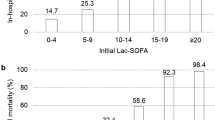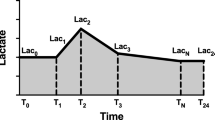Abstract
To analyze the prognostic value of lactate levels for day-7 and in-hospital mortality, in septic patients with and without shock. In the period November 2011–December 2016, we enrolled 268 patients, admitted to our High-Dependency Unit with a diagnosis of sepsis. Lactate dosage was performed at ED-HDU admission (T0), after 2 h (T2), 6 h (T6) and 24 h (T24); lactate clearance was calculated at T2 and T6 [T2: ((LAC T0—LAC T2/LAC T0)*100)]; T6: [(LAC T0—LAC T6/LAC T0)*100]. The end-points were day-7 and in-hospital mortality. At every evaluation, the lactate level was higher in patients with shock than in those without (T0 3.8 ± 3.8 vs 2.4 ± 2.1; T6 2.9 ± 3.2 vs 1.6 ± 1.1; T24 3.0 ± 4.4 vs 1.4 ± 0.9 meq/L, all p < 0.001). Among patients with shock, an analysis for repeated measures confirmed a more marked lactate level reduction in survivors compared with non-survivors, both by day-7 and in-hospital mortality (p = 0.057 and p = 0.006). A Kaplan–MeIer analysis confirmed a significantly better day-7 survival in patients with T6 (with shock 86% vs 70%; without shock 93% vs 82, all p < 0.05) and T24 (with shock 86% vs 70%; without shock 93% vs 82, all p < 0.05) lactate ≤ 2 meq/L, compared with patients with higher levels. A T6 lactate clearance > 10% was more frequent among in-hospital survivors in the whole study population (57% vs 39%) and in patients with shock (74% vs 46%, all p < 0.05). Higher lactate levels and decreased clearance were associated with an increased short-term and intermediate-term mortality regardless of the presence of shock.



Similar content being viewed by others
References
Fuller BM, Dellinger RP (2012) Lactate as a hemodynamic marker in the critically ill. Curr Opin Crit Care 18:267–272
Ryoo SM, Lee J, Lee YS, Lee JH, Lim KS, Huh JW et al (2018) Lactate level versus lactate clearance for predicting mortality in patients with septic shock defined by sepsis-3. Crit Care Med 46:E489–E495
Levy B (2006) Lactate and shock state: the metabolic view. Curr Opin Crit Care 12:315–321
Levy MM, Evans LE, Rhodes A (2018) The surviving sepsis campaign bundle: 2018 update. Crit Care Med 46:997–1000
Innocenti F, Bianchi S, Guerrini E, Vicidomini S, Conti A, Zanobetti M et al (2014) Prognostic scores for early stratification of septic patients admitted to an emergency department-high dependency unit. Eur J Emerg Med 21:254–259
Levy MM, Fink MP, Marshall JC, Abraham E, Angus D, Cook D et al (2003) 2001 SCCM/ESICM/ACCP/ATS/SIS international sepsis definitions conference. Crit Care Med 31:1250–1256
Oberholzer A, Souza SM, Tschoeke SK, Oberholzer C, Abouhamze A, Pribble JP et al (2005) Plasma cytokine measurements augment prognostic scores as indicators of outcome in patients with severe sepsis. Shock 23:488–493
Shapiro NI, Schuetz P, Yano K, Sorasaki M, Parikh SM, Jones AE et al (2010) The association of endothelial cell signaling, severity of illness, and organ dysfunction in sepsis. Crit Care 14:R182
Innocenti F, Gori AM, Giusti B, Tozzi C, Donnini C, Meo F et al (2019) Prognostic value of sepsis-induced coagulation abnormalities: an early assessment in the emergency department. Intern Emerg Med 14:459–466
Nichol A, Bailey M, Egi M, Pettila V, French C, Stachowski E et al (2011) Dynamic lactate indices as predictors of outcome in critically ill patients. Crit Care 15:R242
Haas SA, Lange T, Saugel B, Petzoldt M, Fuhrmann V, Metschke M et al (2016) Severe hyperlactatemia, lactate clearance and mortality in unselected critically ill patients. Intensive Care Med 42:202–210
Shankar-Hari M, Phillips GS, Levy ML, Seymour CW, Liu VX, Deutschman CS et al (2016) Developing a new definition and assessing new clinical criteria for septic shock: for the third international consensus definitions for sepsis and septic shock (Sepsis-3). JAMA 315:775–787
Levy B, Gibot S, Franck P, Cravoisy A, Bollaert PE (2005) Relation between muscle Na+K+ ATPase activity and raised lactate concentrations in septic shock: a prospective study. Lancet 365:871–875
Ryoo SM, Ahn R, Lee J, Sohn CH, Seo DW, Huh JW et al (2018) Timing of repeated lactate measurement in patients with septic shock at the emergency department. Am J Med Sci 356:97–102
Jones AE, Shapiro NI, Trzeciak S, Arnold RC, Claremont HA, Kline JA (2010) Lactate clearance vs central venous oxygen saturation as goals of early sepsis therapy: a randomized clinical trial. JAMA 303:739–746
Dettmer M, Holthaus CV, Fuller BM (2015) The impact of serial lactate monitoring on emergency department resuscitation interventions and clinical outcomes in severe sepsis and septic shock: an observational cohort study. Shock 43:55–61
Nguyen HB, Kuan WS, Batech M, Shrikhande P, Mahadevan M, Li CH et al (2011) Outcome effectiveness of the severe sepsis resuscitation bundle with addition of lactate clearance as a bundle item: a multi-national evaluation. Crit Care 15:R229
Vincent JL, Silva QE, Couto L Jr, Taccone FS (2016) The value of blood lactate kinetics in critically ill patients: a systematic review. Crit Care 20:257
Author information
Authors and Affiliations
Corresponding author
Ethics declarations
Conflict of interest
The authors declare that they have no conflict of interest.
Statement of human and animal rights
The study protocol was approved by the local Ethics Committee (Registration number 21/11).
Informed consent
All subjects provided oral and written informed consent.
Additional information
Publisher's Note
Springer Nature remains neutral with regard to jurisdictional claims in published maps and institutional affiliations.
Rights and permissions
About this article
Cite this article
Innocenti, F., Meo, F., Giacomelli, I. et al. Prognostic value of serial lactate levels in septic patients with and without shock. Intern Emerg Med 14, 1321–1330 (2019). https://doi.org/10.1007/s11739-019-02196-z
Received:
Accepted:
Published:
Issue Date:
DOI: https://doi.org/10.1007/s11739-019-02196-z




